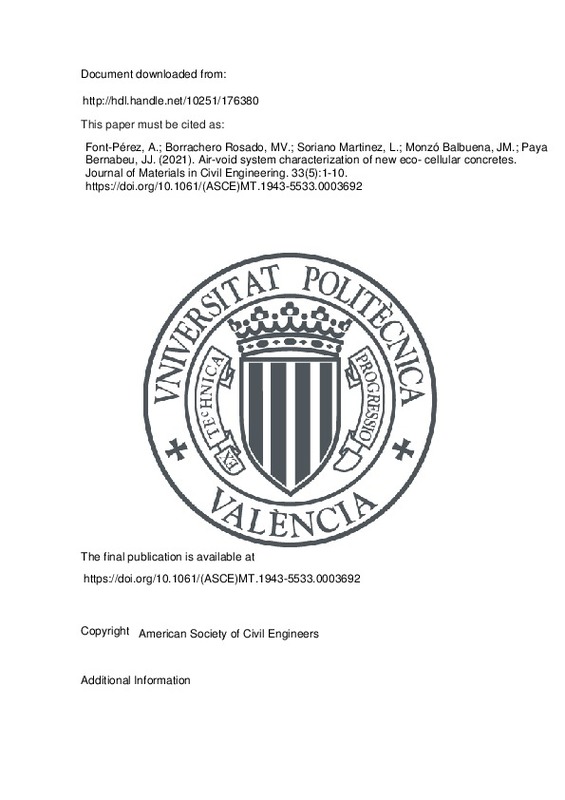JavaScript is disabled for your browser. Some features of this site may not work without it.
Buscar en RiuNet
Listar
Mi cuenta
Estadísticas
Ayuda RiuNet
Admin. UPV
Air-void system characterization of new eco- cellular concretes
Mostrar el registro sencillo del ítem
Ficheros en el ítem
| dc.contributor.author | Font-Pérez, Alba
|
es_ES |
| dc.contributor.author | Borrachero Rosado, María Victoria
|
es_ES |
| dc.contributor.author | Soriano Martinez, Lourdes
|
es_ES |
| dc.contributor.author | Monzó Balbuena, José Mª
|
es_ES |
| dc.contributor.author | Paya Bernabeu, Jorge Juan
|
es_ES |
| dc.date.accessioned | 2021-11-05T14:09:40Z | |
| dc.date.available | 2021-11-05T14:09:40Z | |
| dc.date.issued | 2021-05-01 | es_ES |
| dc.identifier.issn | 0899-1561 | es_ES |
| dc.identifier.uri | http://hdl.handle.net/10251/176380 | |
| dc.description.abstract | [EN] Cellular concrete is an alternative to conventional concrete as a low-density and high-insulating building material. The eco-cellular concretes (ECCs) based on geopolymer technology have been recently introduced by the scientific community. A form of ECC was studied, in which the fluid catalytic cracking residue and the blast furnace slag were employed as precursors, the rice husk ash was utilized as an alternative silica source in the activator, and the aerating reagent was replaced with recycled aluminum foil. Field emission scanning electron microscopy, optical microscopy, and ImageJ version 1.48 software (National Institutes of Health) were employed to characterize the void distribution. Bulk density and porosity were determined by hydric tests. The results revealed that lowest densities without strength loss were obtained when the cementing matrix had a homogeneous void system: similar spacing between pores, narrow size ranges, and nonconnected pores. A relationship was established between open and closed porosity with density and thermal conductivity. | es_ES |
| dc.description.sponsorship | The authors acknowledge the financial support from the Universitat Politecnica de Valencia (UPV) through internal project GEOCELPLUS. The authors are especially grateful to Dr. Josefa L. Rosello Caselles for the recycled aluminum foil, and also to the Electronic Microscopy Service of the UPV. Thanks also go to DACSA, BP Oil, and Cementval for supplying the raw materials. | es_ES |
| dc.language | Inglés | es_ES |
| dc.publisher | American Society of Civil Engineers | es_ES |
| dc.relation.ispartof | Journal of Materials in Civil Engineering | es_ES |
| dc.rights | Reserva de todos los derechos | es_ES |
| dc.subject | Cellular concrete | es_ES |
| dc.subject | Blast furnace slag | es_ES |
| dc.subject | Fluid catalytic cracking residue | es_ES |
| dc.subject | Rice husk ash | es_ES |
| dc.subject | Thermal insulation | es_ES |
| dc.subject | Pore system | es_ES |
| dc.subject.classification | INGENIERIA DE LA CONSTRUCCION | es_ES |
| dc.title | Air-void system characterization of new eco- cellular concretes | es_ES |
| dc.type | Artículo | es_ES |
| dc.identifier.doi | 10.1061/(ASCE)MT.1943-5533.0003692 | es_ES |
| dc.rights.accessRights | Abierto | es_ES |
| dc.contributor.affiliation | Universitat Politècnica de València. Departamento de Ingeniería de la Construcción y de Proyectos de Ingeniería Civil - Departament d'Enginyeria de la Construcció i de Projectes d'Enginyeria Civil | es_ES |
| dc.description.bibliographicCitation | Font-Pérez, A.; Borrachero Rosado, MV.; Soriano Martinez, L.; Monzó Balbuena, JM.; Paya Bernabeu, JJ. (2021). Air-void system characterization of new eco- cellular concretes. Journal of Materials in Civil Engineering. 33(5):1-10. https://doi.org/10.1061/(ASCE)MT.1943-5533.0003692 | es_ES |
| dc.description.accrualMethod | S | es_ES |
| dc.relation.publisherversion | https://doi.org/10.1061/(ASCE)MT.1943-5533.0003692 | es_ES |
| dc.description.upvformatpinicio | 1 | es_ES |
| dc.description.upvformatpfin | 10 | es_ES |
| dc.type.version | info:eu-repo/semantics/publishedVersion | es_ES |
| dc.description.volume | 33 | es_ES |
| dc.description.issue | 5 | es_ES |
| dc.relation.pasarela | S\431176 | es_ES |
| dc.contributor.funder | Universitat Politècnica de València | es_ES |
| dc.subject.ods | 11.- Conseguir que las ciudades y los asentamientos humanos sean inclusivos, seguros, resilientes y sostenibles | es_ES |







![[Cerrado]](/themes/UPV/images/candado.png)

